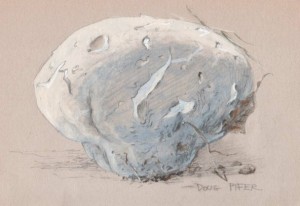The Trees And Crafts Of Moosewood Apple Farm
By Annie Young
As you pull into Moose Apple Farm, you’ll first see the trees. Rows and rows of deciduous trees stretching up and down the soft sloping hills nestled into the turn of the road. Next, you’ll be welcomed by a log home with a wraparound porch decorated with antiques and seasonal decor. You may even be greeted by a wooden figurine sign saying, “The witch is in.”
But when we entered we found no witch, just a peacefully busy mother and daughter decorating and checking inventory for the upcoming holiday season. The Rasnic Family is hard at work creating unique crafts and growing Christmas trees to provide customers with memories and mementos.
In 2008 Paris and Kathy Rasnic moved into their new home and began selling Christmas trees at Moose Apple Farm. They had planted their first trees in 2000. Today they have over 25,000 trees in seven species—Norway spruce, blue spruce, white spruce, white pine and scotch pine, Douglas fir and the concolor fir.
The concolor fir is a relatively new variety in our area. It has long, soft needles that won’t prick you when you are decorating, but with branches strong enough to hold heavy ornaments. The concolor also has excellent needle retention and has citrus scent—when I rubbed the needles it evoked oranges in my stocking on Christmas Eve morning. The Rasnics have had customers happily report that their trees have kept their needles for a month.
Visitors and customers come for the trees but enjoy the open hills, picnic pavilion, scenic vistas, and seasonal decorations that include an antique Amish sleigh. The Rasnics invite people to take pictures with the sleigh; they’ve even had customers bring professional photographers for their Christmas card photos. One Clarke County man proposed to his future wife at the farm in front of a Christmas tree covered with bulbs saying “Will you marry me?”
Back in the gift shop it feels like Santa’s workshop—if Santa made crafts instead of toys. The large Great Room has wreaths, stained glass ornaments, sun catchers, handmade wooden interior decor, local syrups, and all things “Moosey.” Wreaths made daily are sold with a wide variety of ribbons to fit any style. The Rasnics use their own freshly harvested pine. Customers can buy the greenery and white pine garlands for their homes.
Rasnic family members are not only farmers; they are craftsmen and artisans. The wooden decorations are all made by Paris and hand painted by Kathy, who often creates custom paintings for customers. One old-timey Santa painting has a Naughty-Nice list that includes family members’ names. There is an antique milk canister painted with a scene depicting a personalized train and the family’s alma maters.
Tamara, Paris and Kathy’s daughter, is an artist working in glass. She created ornaments, sun catchers, mosaics and night light covers with glass. Some are created using Tiffany style stained glass while others are created using a fusion process. The sunlight streaming through the windows illuminates the ornaments—the ornaments also can be customized. Tamara spends the year creating objects for the gift shop. She says when she first got her kiln she couldn’t sleep at night because she had so many new ideas of things to create.
Back outside again, you can choose your tree from the full array of rows. When you go to cut your tree, the farm provides tags and a map to mark the special spot where you found your Christmas tree. Tagging trees began the first weekend of October. Cutting trees begins the weekend before Thanksgiving and continues until Christmas eve for those last minute decorators. Customers can cut their own trees with saws provided for them by the farm. Assistance for hauling the trees from the field, shaking, baling, and loading is available.
Take some time this holiday season to come on down to Moosewood Farm. In fact, it might take some time to find a tree with 25,000 to choose from!
The farm and gift shop are open every weekend, 10am to 4pm. 2425 Wickliffe Road, Berryville; on the web at MooseAppleChristmasTreeFarm.com and by phone at 540-955-2450.





